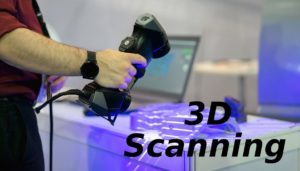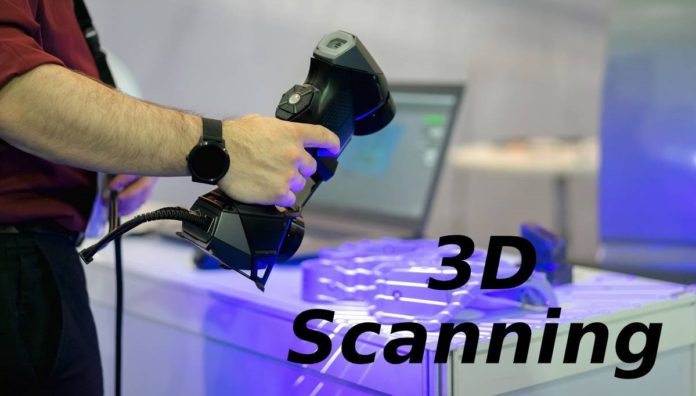 A digital 3D model of real-world object or environment which was just an imaginary concept years ago is now a reality—all thanks to 3D scanning technology. 3D scanning is a technology which can analyze real-world objects or environment and collect data such as color, texture, shape, and other specifications of the object that is scanned. This data can then be utilized to develop a digital 3D model of that object.
A digital 3D model of real-world object or environment which was just an imaginary concept years ago is now a reality—all thanks to 3D scanning technology. 3D scanning is a technology which can analyze real-world objects or environment and collect data such as color, texture, shape, and other specifications of the object that is scanned. This data can then be utilized to develop a digital 3D model of that object.
Growing demand for 3D scanning technology
With its ground-breaking results and efficiency, 3D scanning technology has now become one of the most vital parts of nearly all the industries and services all over the world. Be it health care sector or engineering companies or even the police department the applications of 3D scanning technology are growing day by day at a very increasing speed.
Recently, a news from Times of India reported the use of 3D scanning technology for documenting crime scenes digitally. The cops used a device named ‘Crime Scene Scanner’, which is equipped with an inbuilt camera and high-frequency infrared laser. A senior police officer said that the department believes in technology as one of the key features of the state government’s 5T initiative. Hence, a tender has been floated to obtain six crime scene scanner sets in the first phase.
Up till now, police used to follow the conventional methods of documenting a crime scene. They used to document the entire scene on paper, click and shoot the crime spots using a digital camera and then upload it to the computer. All this process is sure to have some human errors and hence hamper the accuracy. 3D laser scanners will avoid investigating officers from visiting a crime spot repeatedly in search of some proofs. By using 3D scanners, they will be able to digitally protect the minute details of the crime spots and eradicate human errors, time wasted in manual documentation, and staffs assigned for the task. These scanners also support 3D software for performing bullet trajectory examination, blood splatter analysis, vehicle crash analysis, and any other advanced crime scene investigations.
Various 3D scanning technologies are available today some of them are listed below:
- Photogrammetry
This technique binds together snapshots of an object that are captured from varied angles. These pictures are taken with a smartphone or a digital camera, while the combining of these photographs is carried out using a distinct software. The software recognizes pixels which look similar to the same physical point and develops a 3D view of the object.
- Light-based scanning
In this technique, by projecting light on a real-world object certain metrics are measured to reconstruct the digital 3D view of the object. There are two forms of light scanning techniques:
The first one includes projecting patterns on the object. The different angles of the object deforms the shape that was projected on it, measures these deformations, and then redesigns a 3D model.
The second method throws laser projections on the object. The laser gets deflected by different angles in varied places with respect to the surface of the object, measures these deflections, and then transforms them into coordinates of the 3D model. In the end, a 3D mesh of the object is created.
- Contact scanning
This scanning technique contains a physical contact of a probe onto the surface of the object being scanned. Initially, the object is kept in place such that it does not move. Later, the touching probe is moved all over the object in order to obtain the details of the object and all the 3D data that is essential to produce a digital copy.
- Laser Pulse scanning
In this technique, a light scanner throws a laser stream of light on the surface of the object. Later, the laser reflects and cames back back to a sensor. Here, the total time between the projection and the reflection is calculated and interpreted as geometric data. In this type, a mirror is placed on the laser scanner, which allows the laser beam to cover all the points on an object’s surface. The accuracy of this technique is very high as millions of laser pulses are projected and received in a very short time.
Applications of 3D scanning
3D scanning is not just used for redesigning objects or developing models for 3D printing, but also used in various other applications. This technology can safely preserve prehistoric artworks and guard it from any damage. It is also showing its wonders in areas such as healthcare where a broken skull can be reconstructed with 3D scanned models or prosthetics can be custom made.
Trends show that 3D scanning is widely used in construction industry for reducing the housing crisis. This technology helps in developing buildings within a short period of time. Therefore, industries are now focusing on 3D scanning technology to gain traction in the market. Key players operating in the 3D scanning industry includes 3D Digital Corporation, Faro Technologies, Inc., Direct Dimensions, Inc., Konica Minolta, Inc., Autodesk, Inc., Creaform, Inc., GOM mbH, and others. Also, as per the data given by a report by Big Market Research, the 3D scanning market is expected to grow at a striking growth rate of 25.7% from 2018 to 2025.
This just doesn’t end here, even the entertainment industry is making the right use of 3D scanning technology. The special effects in movies as well as animated movies are all an outcome of 3D scanning technology. Besides this, the aeronautics and automotive companies are also using 3D scanning techniques to produce designs and models.
Anil Gawade






